What Is the Candida auris (C. auris) Superbug?
Overview
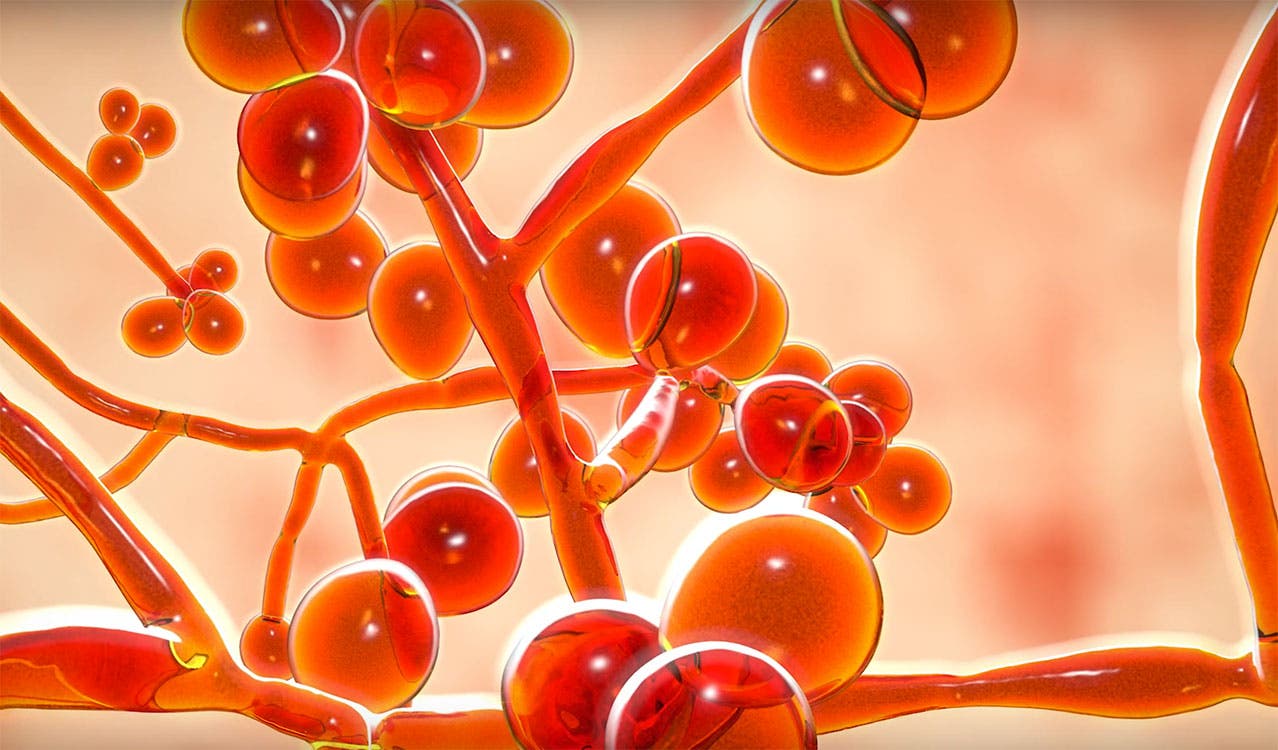
Candida auris (C. auris) is an emerging pathogenic fungus first identified in 2009. Pandemic-related strain on the healthcare and public health systems allowed C. auris to spread at an alarming rate in U.S. healthcare facilities. C. auris, a type of yeast, causes severe illness in hospitalized patients in healthcare facilities across the globe. This fungus can colonize the skin and has been isolated from multiple infection sites in the body. It can cause serious invasive infections. There are limited antifungal drugs commonly used to treat Candida infections, but like other “superbugs,” C. auris is often resistant to one or more of these medications. Additionally, Candida auris can be difficult to identify using standard laboratory testing and is often misidentified, which can delay appropriate treatment and precautions, and can make it difficult to control its spread in healthcare settings. Healthcare transmission is responsible for most, if not all, cases. In healthcare settings, C. auris has been documented to spread through contact with contaminated surfaces or equipment and from patient to patient.1,2,3
Basic Facts
What is C. auris?
Candida auris (C. auris), a type of yeast, is an emerging fungus that can cause infections anywhere in the body, including the more worrisome severe invasive infections such as bloodstream infections. It was first identified in Japan in 2009, and infections have now been reported on every populated continent, including in North America and the United States. The risk to the general public and otherwise healthy people, including healthcare workers, is extremely low.1,4
What are the symptoms of a C. auris infection?
Candida auris infection symptoms can vary greatly and are associated with the infected body site. Patients at highest risk of an invasive Candida infection are usually already ill from other medical conditions or have spent a prolonged time in healthcare settings — particularly long-term acute care hospitals (LTACHS) or ventilator-capable skilled nursing facilities (vSNFs)—and have lines and tubes that go into their body (such as breathing tubes, feeding tubes, and central venous catheters), making them more vulnerable. The most common symptoms of invasive Candida infection are fever and chills that do not improve after antibiotic treatment for a suspected bacterial infection.1,2
How does C. auris spread?
While more research is still needed to further study how it spreads, C. auris has caused outbreaks within healthcare facilities via person-to-person contact and through contaminated surfaces or equipment. Effective cleaning and disinfection protocols are essential in preventing the spread of C. auris because the fungus can live on surfaces for several weeks.2
Why is C. auris a concern?
The Centers for Disease Control and Prevention (CDC) considers Candida auris an urgent threat. The CDC is concerned about C. auris because, like other “superbugs,” it is often multi-drug resistant, has a high mortality rate, is difficult to identify with standard laboratory tests, and it has caused outbreaks in healthcare settings.3,5
Candida auris Infection Control Measures
- Emphasize adherence to hand hygiene protocols.
- Place C. auris patients in single-patient rooms with dedicated medical equipment and implement standard and contact precautions.
- Perform enhanced cleaning and disinfection of patient care environments and reusable equipment (2-3 times daily and terminal cleaning) with CDC-recommended products.
- Conduct surveillance for new C. auris cases and outbreaks.6
- Screen contacts of newly identified case patients to identify C. auris colonization.
- Prior to transfer, inform receiving facilities of patients with C. auris. The CDC Inter-Facility Infection Control Transfer Form assists in fostering communication during transitions of care.7
Candida auris Resources
Educational Resources
Videos
Education Sheets
Educational Courses (CE Credits Available)
Clinical Evidence
Blogs
- The Problem(s) with Candida auris
- Fungal Pathogens with Sticking Sticking Power
- The COVID-19 Pandemic’s Impact on Two Urgent-threat Pathogens: Candida auris and Clostridioides difficile
- Candida auris – An Emerging and Difficult Threat
- The Next Normal for Healthcare Cleaning and Disinfection
- So You Think You Have an Outbreak of [insert pathogen here]: Now What?
Products for Use Against Candida auris
Cleaning & Disinfecting
The CDC recommends use of a hospital-grade disinfectant that is registered with the Environmental Protection Agency (EPA) and is effective against C. auris (see EPA List P).8 If a product with an EPA claim is not accessible or otherwise suitable, the CDC recommends using a disinfectant that is effective against C. difficile (see EPA List K).9 Disinfectants with an EPA claim for C. difficile have been used effectively against C. auris. It is important to follow the directions for use, including applying the product for the correct contact time. Increased attention to detail and monitoring for compliance should include:
- Surfaces in patient rooms, with special attention to high-touch surfaces and the bed-space area
- Surfaces in areas where patients receive care (e.g., radiology, physical therapy, etc.)
- Mobile and shared equipment (e.g., ventilators, physical therapy equipment, thermometer probes)10
Clorox Healthcare Product Recommendations
The following Clorox Healthcare cleaner disinfectants can be used to effectively manage Candida auris on environmental surfaces and equipment in healthcare settings:
Products for Use Against Candida auris
| PRODUCT | PRODUCT IMAGE | EPA REG. NO. | C. AURIS CONTACT TIME (EPA LIST P) |
C. DIFF CONTACT TIME (EPA LIST K) |
| Clorox Healthcare® Bleach Germicidal Wipes 6″ x 5″ Clinical Wipes, 6/150 ct., Item No. 30577 6.75″ x 9″ Multipurpose Wipes, 6/70 ct., Item No. 35309 6.75″ x 9″ Softpack, 9/100 ct., Item No. 32621 6.75″ x 9″ Individual Wipes, 6/50 ct., Item No. 31424 12″ x 12″ Terminal Wipes, 2/110 ct., Item No. 30358 12″ x 12″ Terminal Wipes Refill, 2/110 ct., Item No. 30359 |
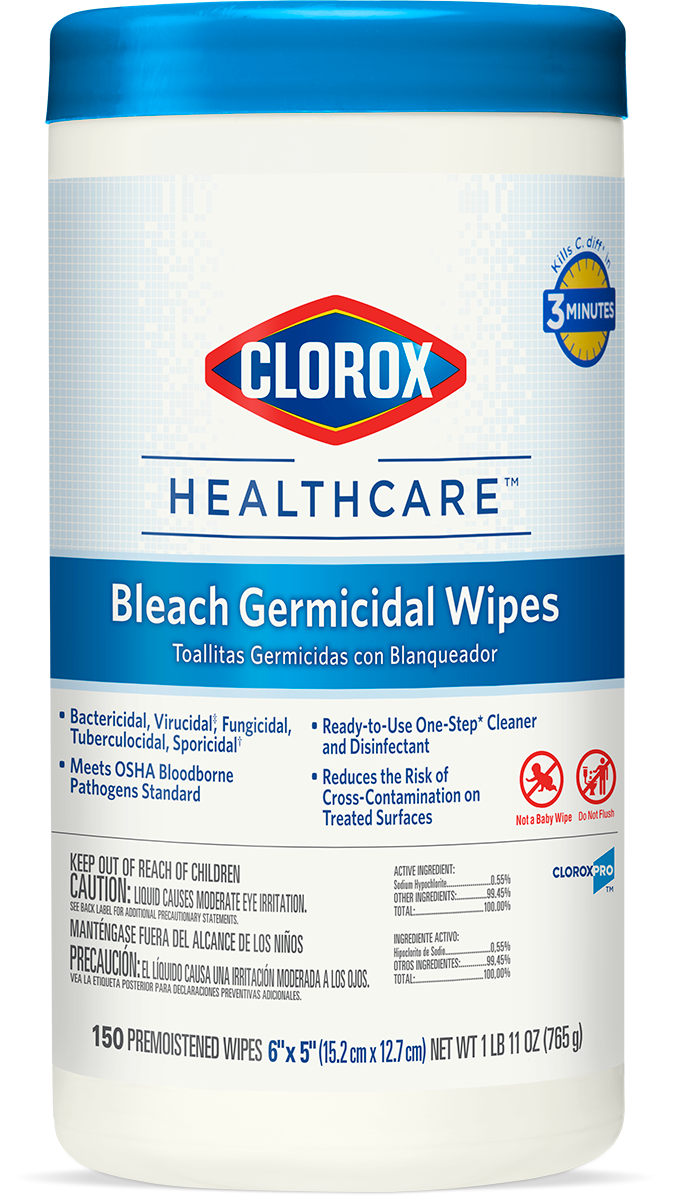 |
67619-12 | 3 min | 3 min |
| Clorox Healthcare® Bleach Germicidal Cleaner 6/32 fl. oz. Spray, Item No. 30577 6/32 fl. oz. Pull-Top, Item No. 68832 4/128 fl. oz. Refill, Item No. 68978 |
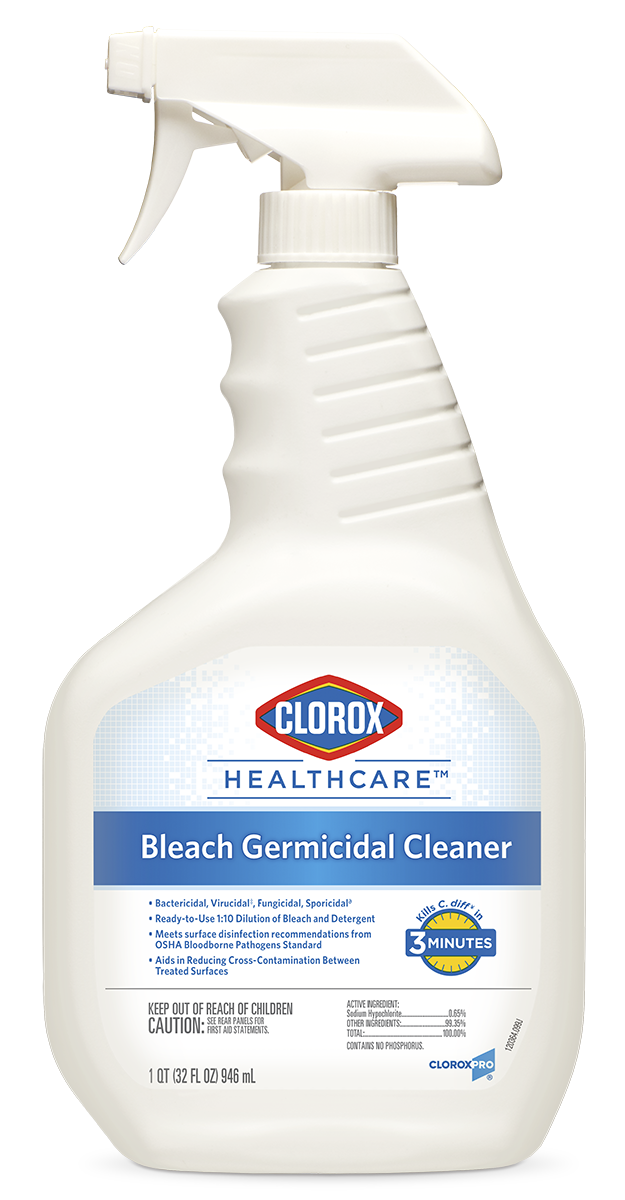 |
56329-7 | 3 min | 3 min |
| Clorox Healthcare® Spore10 Defense® Cleaner Disinfectant 4/128 fl. oz. for Total 360® Devices, Item No. 32122 4/128 fl. oz. Ready-to-use, Item No. 32409 |
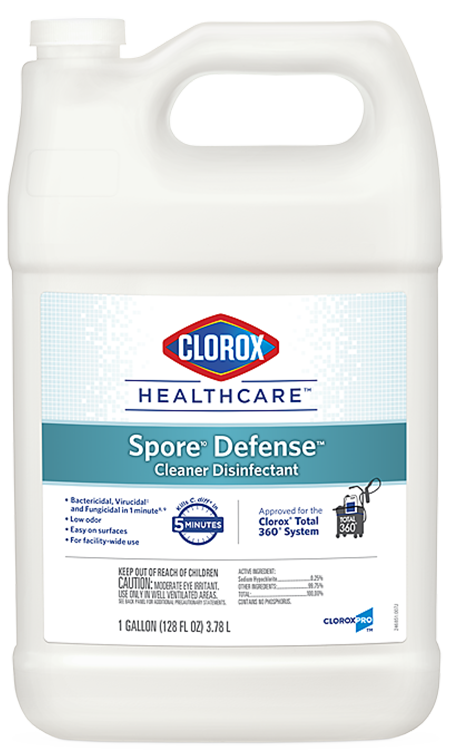 |
67619-40 | 3 min | 5 min |
| Clorox Healthcare® Hydrogen Peroxide Cleaner Disinfectant Liquids 9/32 fl. oz. Spray, Item No. 30828 6/32 fl. oz. Pull-Top, Item No. 31444 4/128 fl. oz. Refill, Item No. 30829 |
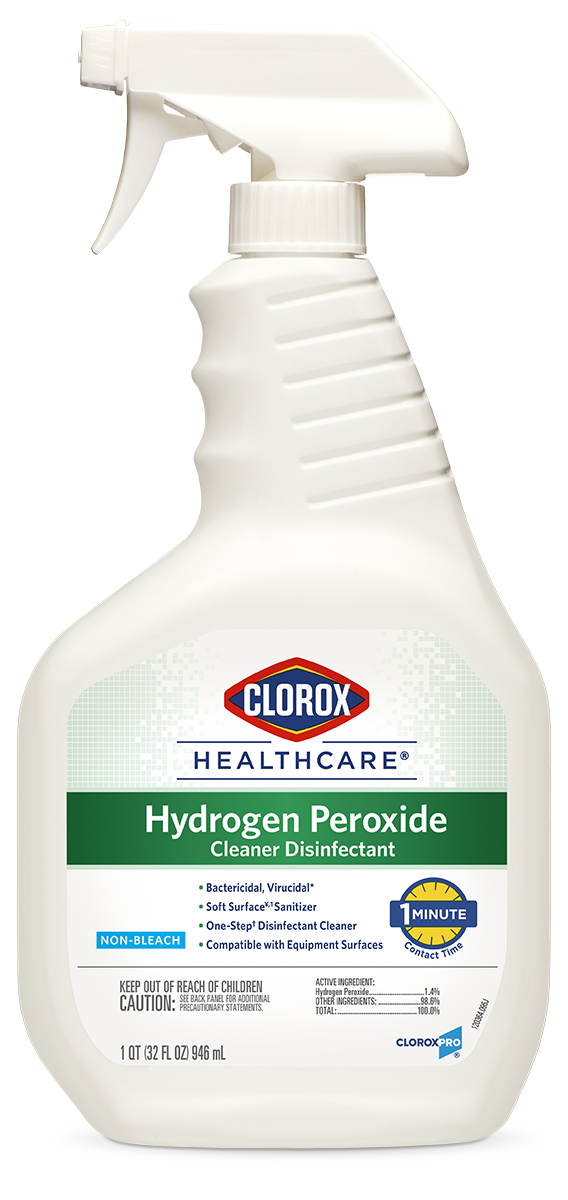 |
67619-24 | 2 min | — |
| Clorox Healthcare® Hydrogen Peroxide Cleaner Disinfectant Wipes 6.75″ x 9″ Multipurpose Wipes, 6/95 ct., Item No. 30824 6.75″ x 5.75″ Clinical Wipes, 6/155 ct., Item No. 30825 12″ x 11″ Terminal Wipes, 2/185 ct. bucket, Item No. 30826 12″ x 11″ Terminal Wipes, 2/185 ct. refill pouch, Item No. 30827 |
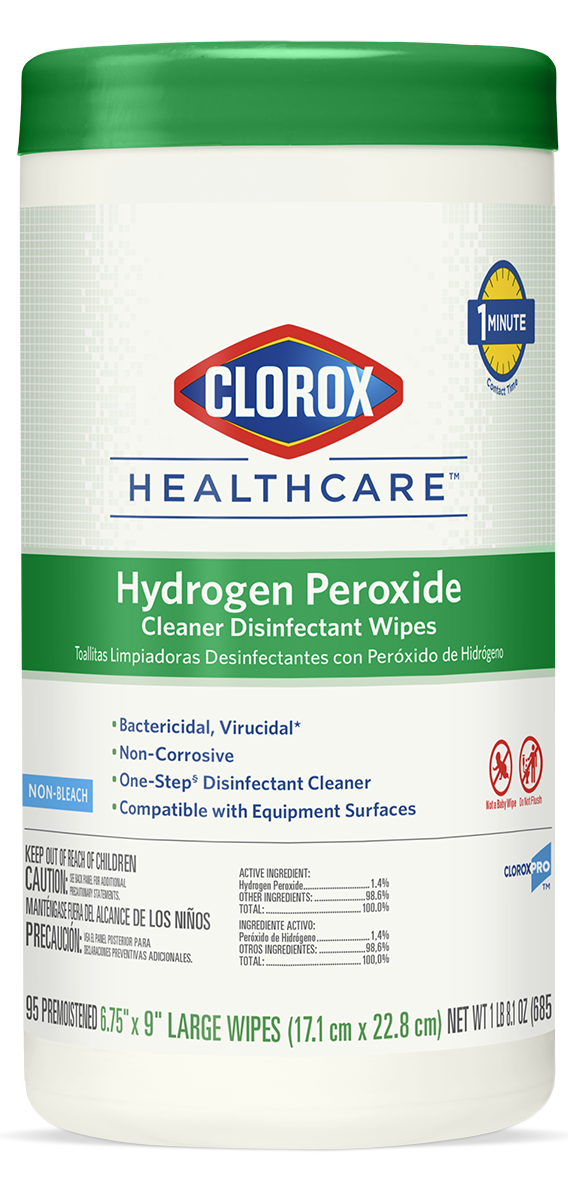 |
67619-25 | 2 min | — |
| Clorox Healthcare® Fuzion® Cleaner Disinfectant 9/32 fl. oz. Spray, Item No. 31478 |
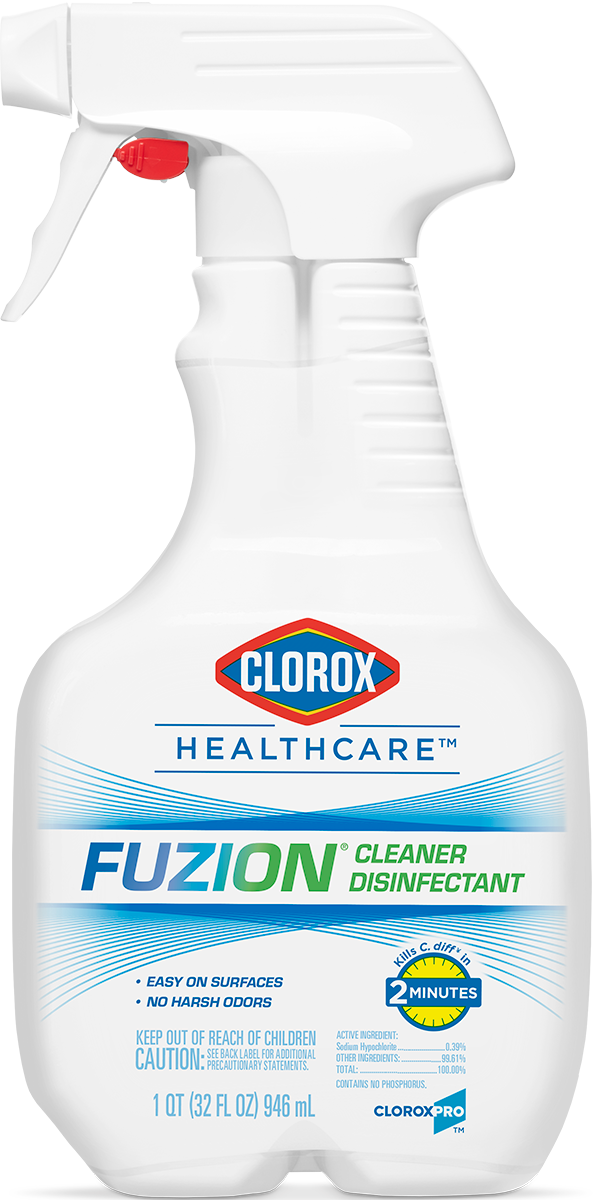 |
67619-30 | — | 90 sec |
| Dispatch® Hospital Cleaner Disinfectant Towels 6.75″ x 8″ Canister, 8/150 ct., Item No. 69150 |
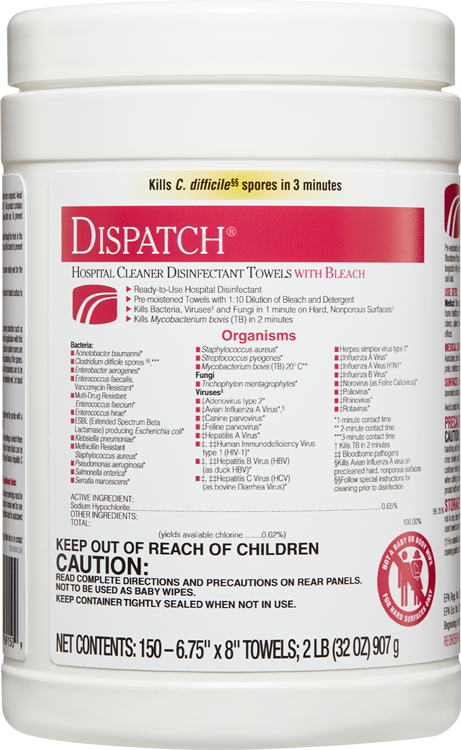 |
56392-8 | — | 3 min |
| Clorox® Germicidal Bleach 3/121 fl. oz. Bottle, Item No. 30966 |
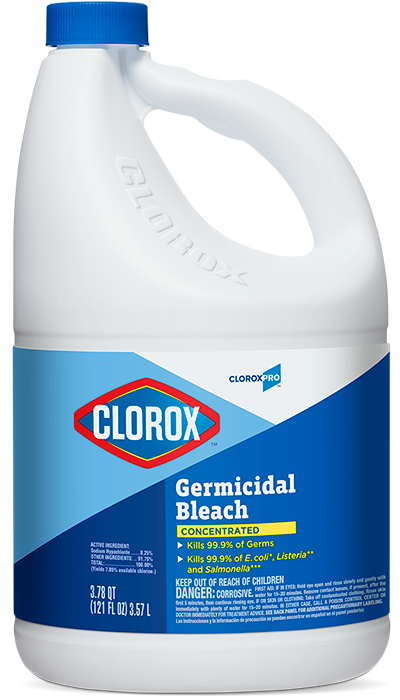 |
67619-32 | — | 3 min |
References
1. Lyman M, Forsberg K, Sexton DJ, Chow N, Lockhart SR, Jackson BR, Chiller T. Worsening Spread of Candida auris in the United States, 2019-2021. Ann Intern Med. 2023 Mar; https://doi.org/10.7326/M22-3469.
2. General Information about Candida auris | Candida auris | Fungal Diseases | CDC https://www.cdc.gov/fungal/candida-auris/candida-auris-qanda.html (accessed 2022-05-03).
3. World Health Organization (WHO). WHO fungal priority pathogen list to guide research, development and public health action [Internet]. [cited 2023 Mar 27]. Available from https://www.who.int/publications/i/item/9789240060241.
4. Tracking Candida auris | Candida auris | Fungal Diseases | CDC https://www.cdc.gov/fungal/candida-auris/tracking-c-auris.html (accessed 2022-05-03).
5. Healthcare Professionals FAQ | Candida auris | Fungal Diseases | CDC https://www.cdc.gov/fungal/candida-auris/c-auris-health-qa.html (accessed 2022-05-03).
6. Surveillance for Candida auris | Candida auris | Fungal Diseases | CDC https://www.cdc.gov/fungal/candida-auris/c-auris-surveillance.html (accessed 2022-05-03).
7. Centers for Disease Control and Prevention. Inter-Facility Infection Control Transfer Form for States Establishing HAI Prevention Collaboratives.
8. List P: Antimicrobial Products Registered with EPA for Claims Against Candida auris | US EPA https://www.epa.gov/pesticide-registration/list-p-antimicrobial-products-registered-epa-claims-against-candida-auris (accessed 2022-05-03).
9. List K: EPA’s Registered Antimicrobial Products Effective against Clostridium difficile Spores | US EPA https://www.epa.gov/pesticide-registration/list-k-epas-registered-antimicrobial-products-effective-against-clostridium (accessed 2022-05-03).
10. Infection Prevention and Control for Candida auris | Candida auris | Fungal Diseases | CDC https://www.cdc.gov/fungal/candida-auris/c-auris-infection-control.html (accessed 2022-05-03).



